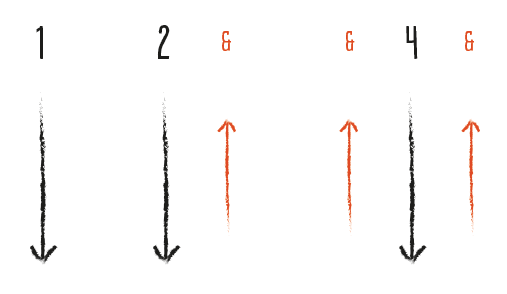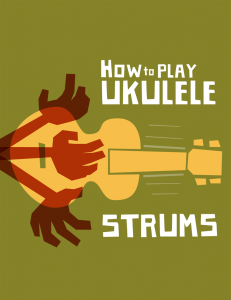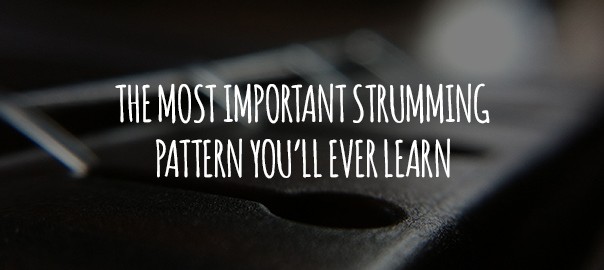If you were only ever going to learn one strumming pattern assuming that you’ve got a few basic strumming patterns down, I’d definitely recommend you make it this one. I’ve heard this strumming pattern referred to as ‘old faithful‘ in the past because of it’s versatility. It works on just about any song and is a great pattern to default back to if you’re not sure what pattern you should be playing…
Down Down Up Up Down Up
The pattern follows this rhythm…
D-DU-UDU
The tricky part of this pattern is the missing 3rd down strum, it will take a bit of getting used. If you’re a newcomer to strumming and ukulele then I’d recommend playing it really really slowly to begin with. As ever aim for consistency first not speed. Play it as slowly as you need to in order to keep the rhythm going – even if it sounds ridiculous.

The missing 3rd down strum gives a syncopated feel to the rhythm and that’s what keeps it sounding interesting. Any song with a 4/4 rhythm this will work nicely on – maybe it won’t match the original recorded strumming pattern but it’s a good basis for any rock/pop song.
Practice time
To begin with pick an easy chord (like a C) and repeat bar after bar until you’re almost on autopilot. Don’t worry about chord changes for now, just stick with a single chord until it’s firmly embedded in your memory and your hand is doing the pattern unconsciously .
Chord changes
Once you have the pattern down with a single chord it’s time to throw a chord change (or two) into the mix. Again, I’d pick another easy chord like Am or F as we’re not working on your left hand here (unless you’re left handed that is).
The final up strum is going to make it quite tough to change chord in time for the following down strum that starts the next bar so you need to anticipate the change and start the chord change as soon as you’ve played the 4th down strum. This will mean that for the final up strum your hand won’t actually be fretting a chord at all, it will be between chords, getting ready for the next bar. Don’t worry about this, if anything this will make your rhythm sound that little bit more natural.
Practice this rhythm a little bit each day (add it to your practice routine) and before you know it you’ll have it perfected and can start applying it to songs that you know the chords for.
 Extra Strumming Help
Extra Strumming Help
If you really want to progress your strumming at a rapid rate then I’d highly recommend taking a look at Al Wood’s downloadable ebook How To Play Ukulele Strums. For just $12 you get an in-depth guide showing you how to play 49 different strums with supporting videos and MP3 files. There’s also a really useful section that focuses on counting strums the easy way (something I wish I had when I was learning to play).





Hi Dave,
thank you very much for this very helpful website! I’m just starting to learn to play the ukulele and I really love this D-DU-UDU strumming. The only this is, that I find it impossible to sing something to it. Is this a common beginners problem? I tried “you are my sunshine”… No matter how slow I play 🙁
Thank you for help!
Antonia
Hey Antonia, when it comes to singing over a pattern you need to know it well. Check out this post for more tips on singing and playing at the same time… https://ukulelego.com/articles/learning-sing-play-ukulele-time/
If this is the most important strum, I’m wondering why it doesn’t appear on the list of 32 ukulele strums? It’s almost #6 but not quite… Thanks for the resources, great site!
Hi Sharon,
It’s a good question. I consider it to be basically the same strum as no.6 and I use them pretty interchangeably.
D D U D U D U is the commonest and easiest strum
New to music. Left handed. You are the best instructor I’ve found in the whole World Wide Web. So, I’ve got the Uke upside down, I’m strumming with my left hand…do I reverse the strum pattern? Won’t it sound different if I don’t? ( I’m so clumsy yet, I can’t tell). Thanks for this great site.
I find it difficult to play the Bb major chord when strumming. Can I use the Bb 7 instead.
Short answer to this one Collin is if it sounds good then you can, if it doesn’t then don’t
It’s the 2nd upstrum that always gets me I seem to be only able to do ddudu
The trick is to keep the hand moving even though you’re not hitting the down strum on the third beat
Omg yes true, this is the key! Your arm should be moving up and down to the beat consistently for the most ease in playing
I’ve played the uke for a few years.. and I just realized that I never gave strumming a second thought. I noticed I play basically just one strum pattern on the uke (different on guitar) for almost every song, and I was curious about this strum pattern and why I gravitated toward it without knowing. I Googled it and found this article and yeah, it makes so much sense. It works for every song!!! It feels so right. I’m not the type to try to cover songs exactly or “correctly”… I don’t read the tabs or consider the key (capo )or tempo.. I just play the right chords and sing along for fun… and the wrist just naturally “dances” like this upon the fret. Cool. So for those having a hard time, don’t fret! It’ll probably click in no time. Don’t think too hard! Try to feel it instead
Wait nvm I also religiously use the [down (mute) down (mute)] strum pattern… and the [down up – up – down up – up]. It’s that reggae/ska/punk sound that pairs perfectly with the uke. Still, this one is probably The one to know
I think when you sing, it masks the fact that you might be playing the same pattern but you really start to notice it when you’re not singing.